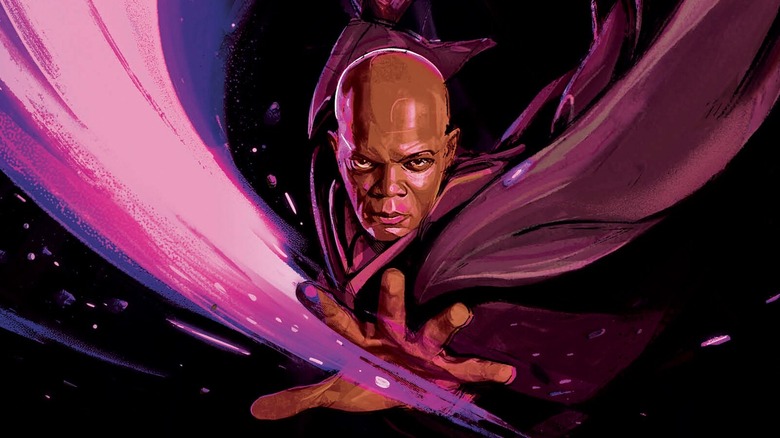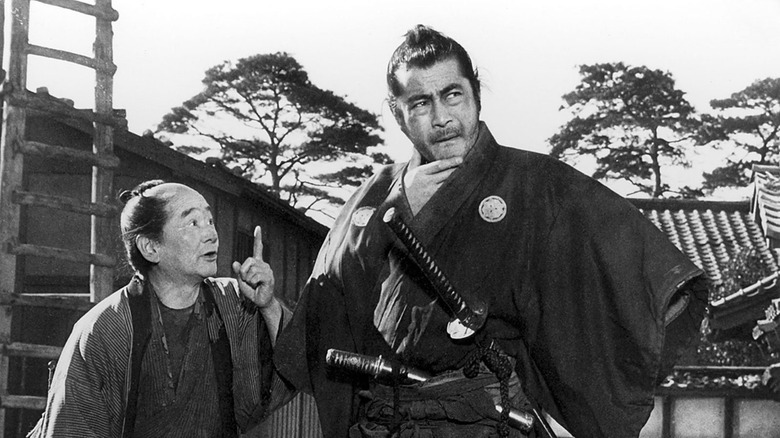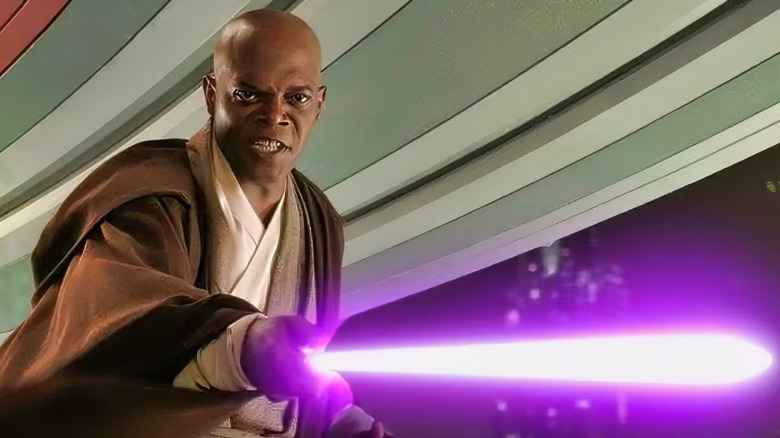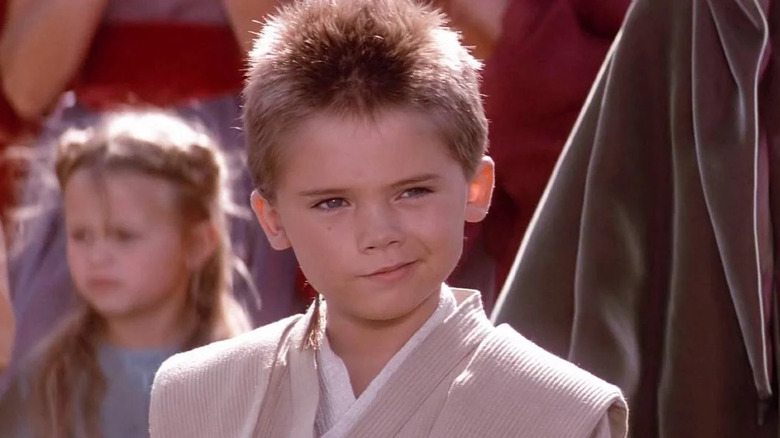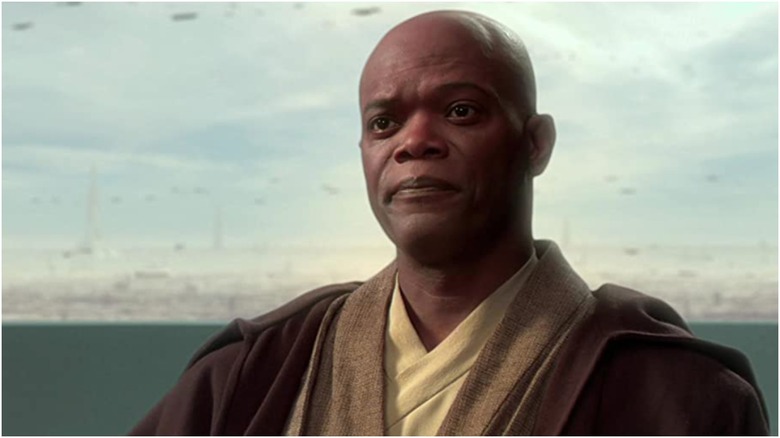A Star Wars Book Reveals An Intriguing Mystery Sparked By Qui-Gon Jinn's Death
We may receive a commission on purchases made from links.
There will be spoilers for "Star Wars: Mace Windu – The Glass Abyss" by Steven Barnes in this article.
An intriguing novel to come from the "Star Wars" universe is "Mace Windu: The Glass Abyss" by Steven Barnes, and it offers a window into one of the most powerful and enigmatic Jedi on the Jedi council and sets him on a noir-style adventure sparked by the death of Qui-Gon Jinn.
Beginning at the tail end of "The Phantom Menace," Mace Windu receives a posthumous message and a request from his now deceased friend and dejarik buddy, Qui-Gon Jinn. The late Jedi has asked him to complete a mission he was unable to on a distant planet. Mace has very little idea what he's getting into, and after some counsel from Master Yoda, finds himself on a planet in the Outer Rim called Metagos. It's known to some as the Glass Abyss. It's a bizarre world where the sun is pumping out harmful radiation and driven everyone underground.
Because of this sudden exodus to the underground parts of the world, two competing groups of gangsters have been able to take over the world. Qui-Gon had promised to bring balance to the planet, but his untimely demise left him unable to do so. Mace Windu is forced to learn about the planet and finish the job for him, but it's a more difficult job than Mace feels prepared for.
The book includes a lot of interesting things to watch out for.
The Glass Abyss calls back to Yojimbo
About a fourth of the way through the book, it's clear the book's structure is patterned after Akira Kurosawa's classic film "Yojimbo." After Mace Windu arrived on the planet, got the lay of the land, and adopted the name Solver as a "Man With No Name" style moniker, he begins to work to play both sides of the criminal empires against each other, just like Toshiro Mifune's titular character in Kurosawa's classic.
There are also times in the book where he is forced to disappear and heal, just like in that film. "Star Wars" has drawn inspiration from Kurosawa since the beginning, whether it's George Lucas using the worm's eye view of the peasants from "The Hidden Fortress" in "A New Hope" or Rian Johnson's masterful use of "Rashomon" in "The Last Jedi," it's an innate part of the "Star Wars" DNA, and Barnes wields it masterfully. Since it's a novel, he's also able to weave it through the standard noir tropes that lend themselves to the sort of storytelling traditions "Yojimbo" grew from. It has a Raymond Chandler vibe that even sees a chapter where a droid puts in an investigation personality chip and starts talking like Sam Spade or Mike Hammer.
Being so stoic, Mace himself makes a good Raymond Chandler stand-in as a stoic Philip Marlowe character. The Jedi played in the films by Samuel L. Jackson has always been tight-lipped and a little too proper, as far as Jedi were concerned, and his thought process matches quite perfectly that mold of story, making this a very natural place for him to occupy in a literary setting. Putting Steven Barnes, a deft writer in his own right in this milieu with this character in this setting was an incredible move from the editors at Lucasfilm and Random House Worlds.
The Glass Abyss explores Mace Windu's Vaapad fighting style
Though Mace Windu's fighting style with a lightsaber, known as Vaapad, has been mentioned a bit in the canon in the last 10 years, we haven't had a deep exploration into it since everything we knew about it reverted to Legends. In the Legends continuity of "Star Wars", Vaapad was a specialty of Mace Windu's. It was a powerful form of lightsaber combat, but was inherently aggressive and bordered on something that could plunge a Jedi to the dark side. "The Glass Abyss" explores it deeply, with Mace Windu practicing it and involving himself in it as a balance between light and dark, but grounding to him.
Mace Windu practices this form repeatedly through the book and elaborates on his philosophy about it. It's a vicious form of fighting, and it can give him an edge in combat, but it is not something that just any Jedi has the mastery of self or the balance to wield and he knows it. Through the course of the book, even Mace himself falls out of balance, though there are other reasons for that. Fans of the old Expanded Universe will be happy to see the depth of its inclusion here in "The Glass Abyss," especially as Mace Windu gets to speak about it in his own words.
The lightsaber combat — in fact all of the combat in general — is well written in the book and does Mace Windu justice. He is a hell of an warrior, and it pays tribute to Anakin's feeling that Mace Windu is one of the most powerful Jedi in the order.
Young Anakin Skywalker makes an appearance
The book also features a number of interesting moments with a very young Anakin Skywalker in the first weeks of his training, a moment we haven't seen a lot in "Star Wars" fiction. One of the most pivotal moments we saw was the aftermath of his surgery in the Jedi Temple to have his explosive slave tracker removed from his body and the scar it left. Though Anakin tried to be brave and fight through the pain it caused, Mace could see it was still hurting the young boy.
Anakin also asked to learn to fight using Windu's Vaapad style, but Mace was hesitant to teach the boy. Mace had always been hesitant to teach the boy. Eventually, the master relented and gave Anakin a taste of the form, and Anakin was able to get a quick handle on it, even as a brand new Padawan. It was fascinating to see Anakin struggle through those early days as a Jedi through the eyes of Mace Windu, who many might look at as one of the people most responsible for Anakin's turn to the dark side. Yes, Windu looked at Anakin with trepidation, but he also held a begrudging respect for the boy, and this book explores the difficulty Windu had in expressing himself fully.
Mace Windu has a broken heart
To wit, Qui-Gon actually left Mace Windu two messages posthumously: one to send him on the mission and another waiting for him if he managed to get through the other side. Somehow, Qui-Gon was able to see enough of the future to know that Mace would and that he would be changed by the experience. And it was an experience Mace Windu needed to open himself up to things, particularly his heart.
Qui-Gon, ever the iconoclast among the Jedi, always knew what to do and say to get the Jedi moving in the right direction again, even if it meant sending Mace Windu on a mission that would force him to kill hundreds of gangsters. But it also got him to come to terms with his inner-self and his inner-feelings and regard himself as someone who can love as a Jedi does, selflessly and constantly.
Mace Windu also struggles with the idea that perhaps he didn't make a choice to be in the Jedi order. The book offers a deeper window into his childhood, including his parents and how he joined the order, but it also allows him to rediscover whether or not he made a choice to be a Jedi. In doing so, it references a moment in "Lone Wolf and Cub", which was itself again echoed with Grogu in "The Book of Boba Fett", where Windu, as an orphaned baby, is given the choice between a trinket from his home planet or a Jedi lightsaber. Naturally, he chose the lightsaber.
But Mace struggles through the book with the choice in his heart: did he truly choose to be a Jedi? He's filled with doubt, and it troubles him. But as he discovers, he has to make that choice every day to remain a Jedi, and the mission helps remind him of that. Qui-Gon knew it would open his eyes to this.
Also, there's the fact that Mace inadvertently gets married during the course of the mission, but that's a different story.
The book was an excellent time and offers much for "Star Wars" fans and has no barrier of entry for readers. If you have seen the prequels, you know everything you need to in order to enjoy this book.
